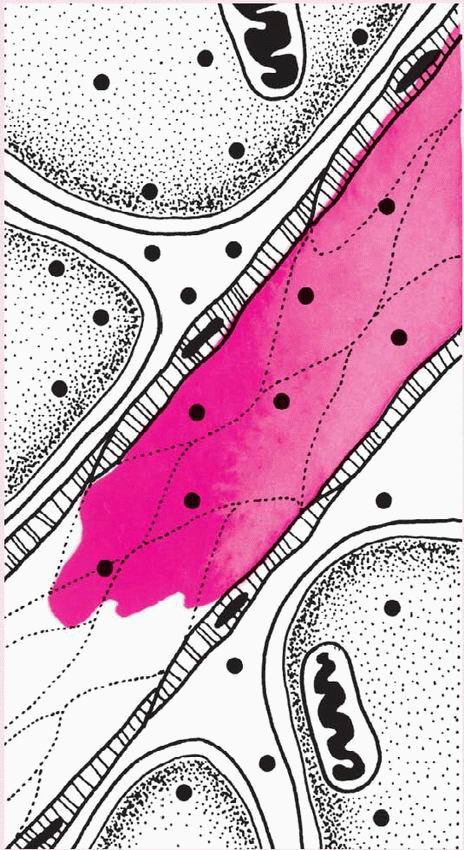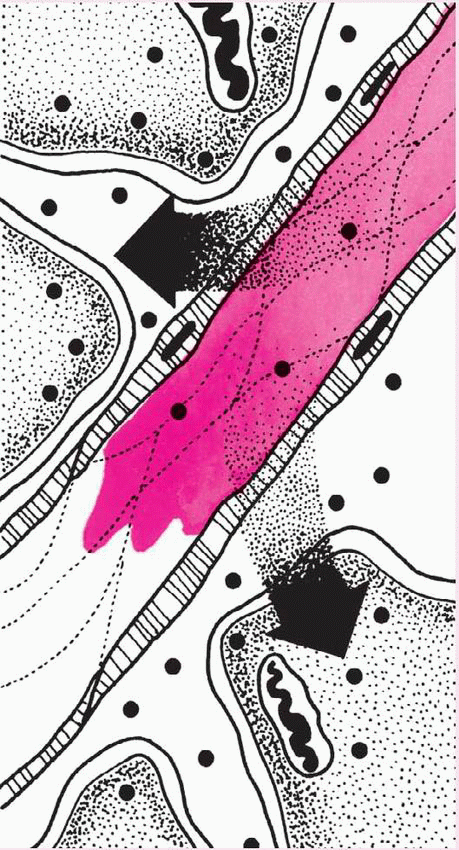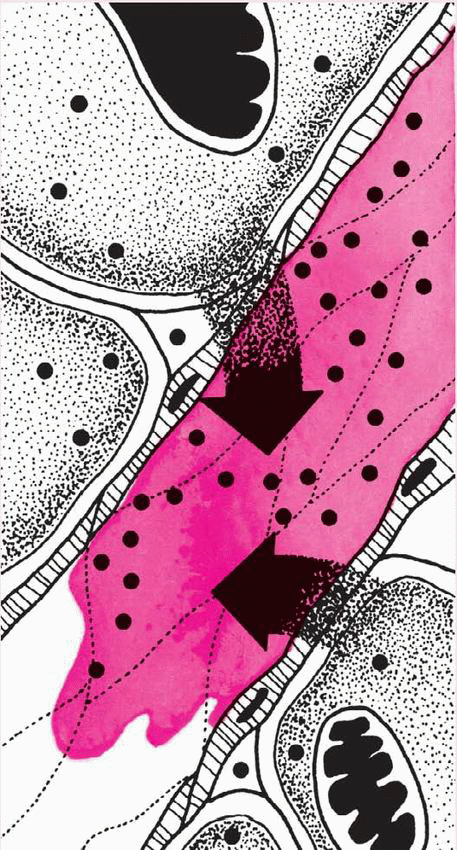balance and electrolyte balance are interdependent. Any change in one alters the other, and any solution given I.V. can affect a patient’s fluid and electrolyte balance.
COMPLICATIONS | SIGNS AND SYMPTOMS | POSSIBLE CAUSES | NURSING INTERVENTIONS |
Local complications | |||
Cannula dislodgment | ♦ Cannula partially backed out of vein ♦ Solution infiltrating | ♦ Loosened tape, or tubing snagged in the bed linens, resulting in partial retraction of the cannula; cannula pulled out by a confused patient | ♦ If no infiltration occurs, retape without pushing the cannula back into the vein. If it has pulled out, apply pressure to the I.V. site with a sterile dressing. Prevention ♦ Tape the venipuncture device securely on insertion. |
Hematoma | ♦ Tenderness at the venipuncture site ♦ Bruised area around the site ♦ Inability to advance or flush the I.V. line | ♦ Puncture of the vein through the opposite wall at the time of insertion ♦ Leakage of blood as a result of needle displacement ♦ Application of inadequate pressure when the cannula is discontinued | ♦ Remove the venous access device. ♦ Apply pressure and warm soaks to the affected area. ♦ Recheck for bleeding. ♦ Document the patient’s condition and your interventions. Prevention ♦ Choose a vein that can accommodate the size of the venous access device. ♦ Release the tourniquet as soon as insertion is successful. |
Infiltration | ♦ Swelling at and above the I.V. site (may extend along the entire limb) ♦ Discomfort, burning, or pain at the site (may be painless) ♦ Tight feeling at the site ♦ Skin cool to the touch around the I.V. site ♦ Blanching at the site ♦ Continuing fluid infusion, even when the vein is occluded, although the rate may decrease | ♦ Venous access device dislodged from the vein, or perforation of the vein | ♦ Stop the infusion. ♦ Check the patient’s pulse and capillary refill periodically to assess circulation. ♦ Restart the infusion above the infiltration site or in another limb. ♦ Document the patient’s condition and your interventions. Prevention ♦ Check the I.V. site frequently. ♦ Don’t obscure the area above the site with tape. ♦ Teach the patient to observe the I.V. site and to report pain or swelling. |
Nerve, tendon, or ligament damage | ♦ Extreme pain (similar to electrical shock when the nerve is punctured) ♦ Numbness and muscle contraction ♦ Delayed effects, including paralysis, numbness, and deformity | ♦ Improper venipuncture technique that causes injury to the surrounding nerves, tendons, or ligaments ♦ Tight taping or improper splinting with an arm board | ♦ Stop the procedure. Prevention ♦ Don’t penetrate the tissues repeatedly with the venous access device. ♦ Don’t apply excessive pressure when taping; don’t encircle the limb with tape. ♦ Pad the arm boards and secure them with tape, if possible. |
Occlusion | ♦ Infusion that doesn’t flow ♦ Pump alarms indicating occlusion | ♦ Interruption of the I.V. flow ♦ Failure to flush the heparin lock ♦ Backflow of blood in the line when the patient walks ♦ Line clamped for too long | ♦ Use a mild flush injection. Don’t force it. If unsuccessful, remove catheter and insert a new one. Prevention ♦ Maintain the I.V. flow rate. ♦ Flush promptly after intermittent piggyback administration. ♦ Have the patient walk with his arm bent at the elbow to reduce the risk of blood backflow. |
Phlebitis | ♦ Tenderness proximal to the venous access device ♦ Redness at the tip of the cannula and along the vein ♦ Vein that’s hard on palpation ♦ Pain during infusion ♦ Possible blanching if vasospasm occurs ♦ Red skin over the vein during infusion ♦ Rapidly developing signs of phlebitis | ♦ Poor blood flow around the venous access device ♦ Friction from movement of the cannula along the vein wall ♦ Venous access device left in the vein for too long ♦ Drug or solution with high or low pH or high osmolarity, such as phenytoin and some antibiotics (erythromycin, nafcillin, and vancomycin) | ♦ Remove the venous access device. ♦ Apply warm soaks. ♦ Notify the physician if the patient has a fever. ♦ Document the patient’s condition and your interventions. ♦ Decrease the flow rate. ♦ Try using an electronic flow device to achieve a steady flow. Prevention ♦ Restart the infusion using a larger vein for an irritating solution, or restart it with a smallergauge device to ensure adequate blood flow. ♦ Tape the device securely to prevent motion. ♦ If long-term therapy with an irritating drug is planned, ask the physician to use a central I.V. line. ♦ Dilute solutions before administration. For example, give antibiotics in a 250-ml solution rather than a 100-ml solution. |
Severed cannula | ♦ Leakage from the shaft of the cannula | ♦ Inadvertent cutting of the cannula by scissors ♦ Reinsertion of the needle into the cannula ♦ Bending of the catheter accidently with movement. | ♦ If the broken part is visible, attempt to retrieve it. If you’re unsuccessful, notify the physician. ♦ If a portion of the cannula enters the bloodstream, place a tourniquet above the I.V. site to prevent progression of the broken part. ♦ Notify the physician and the radiology department stat. ♦ Document the patient’s condition and your interventions. Prevention ♦ Don’t use scissors near the I.V. site. ♦ Never reinsert the needle into the cannula. ♦ Remove the unsuccessfully inserted cannula and the needle together. |
Thrombophlebitis | ♦ Severe discomfort ♦ Reddened, swollen, and hardened vein | ♦ Thrombosis and inflammation | ♦ Follow the procedure for thrombosis. Prevention ♦ Check the site frequently. Remove the venous access device at the first sign of redness and tenderness. |
Thrombosis | ♦ Painful, reddened, and swollen vein ♦ Sluggish or stopped I.V. flow | ♦ Injury to the endothelial cells of the vein wall, allowing platelets to adhere and thrombi to form | ♦ Remove the venous access device, and restart infusion in the opposite limb, if possible. ♦ Apply warm soaks. ♦ Watch for I.V. therapy-related infection; thrombi provide an excellent environment for bacterial growth. Prevention ♦ Use proper venipuncture techniques to reduce injury to the vein. |
Vasovagal reaction | ♦ Sudden pallor, sweating, faintness, dizziness, and nausea ♦ Decreased blood pressure | ♦ Vasospasm as a result of anxiety or pain | ♦ Lower the head of the bed. ♦ Instruct the patient to take deep breaths. ♦ Check the patient’s vital signs. Prevention ♦ Prepare the patient for therapy to relieve his anxiety. ♦ Use a local anesthetic to prevent pain. |
Venous spasm | ♦ Pain along the vein ♦ Sluggish flow rate when the clamp is completely open ♦ Blanched skin over the vein | ♦ Severe irritation of the vein from irritating drugs or fluids ♦ Administration of cold fluids or blood | ♦ Apply warm soaks over the vein and the surrounding area. ♦ Decrease the flow rate. Prevention ♦ Use a blood warmer for blood or packed red blood cells. |
Systemic complications | |||
Air embolism | ♦ Respiratory distress ♦ Unequal breath sounds ♦ Weak pulse ♦ Increased central venous pressure ♦ Decreased blood pressure ♦ Loss of consciousness | ♦ Solution container that’s empty ♦ Solution container that’s emptying, and an added container that’s pushing air down the line (if the line isn’t purged first) ♦ Tubing that’s disconnected | ♦ Discontinue the infusion. ♦ Place the patient on his left side in Trendelenburg’s position to allow air to enter the right atrium and disperse by way of the pulmonary artery. ♦ Give oxygen. ♦ Notify the physician. ♦ Document the patient’s condition and your interventions. Prevention ♦ Purge the tubing of air completely before starting the infusion. ♦ Use an air-detection device on the pump or an aireliminating filter proximal to the I.V. site. ♦ Secure the connections. |
Allergic reaction | ♦ Itching ♦ Watery eyes and nose ♦ Bronchospasm ♦ Wheezing ♦ Urticarial rash ♦ Anaphylactic reaction (flushing, chills, anxiety, itching, palpitations, hypotension, tachycardia, paresthesia, wheezing, seizures, cardiac arrest) up to 1 hour after exposure | ♦ Allergens such as drugs | ♦ If a reaction occurs, stop the infusion immediately. ♦ Maintain a patent airway. ♦ Notify the physician. ♦ Give an antihistaminic steroid, an antiinflammatory, and an antipyretic as prescribed. ♦ Give 1:1,000 aqueous epinephrine subcutaneously as prescribed. Repeat at 3-minute intervals and as needed and prescribed. Prevention ♦ Obtain the patient’s allergy history. Be aware of cross-allergies. ♦ Assist with test dosing, and document any new allergies. ♦ Monitor the patient carefully during the first 15 minutes of giving a new drug. |
Circulatory overload | ♦ Discomfort ♦ Engorgement of the jugular veins ♦ Respiratory distress ♦ Increased blood pressure ♦ Crackles ♦ Increased difference between fluid intake and output | ♦ Loosening of the roller clamp to allow run-on infusion ♦ Flow rate that’s too rapid ♦ Miscalculation of fluid requirements | ♦ Raise the head of the bed. ♦ Give oxygen as needed. ♦ Notify the physician. ♦ Give drugs (probably a diuretic) as prescribed. Prevention ♦ Use a pump, controller, or rate minder for elderly or compromised patients. ♦ Recheck calculations of the fluid requirements. ♦ Monitor the infusion frequently. |
Systemic infection (septicemia or bacteremia) | ♦ Fever, chills, and malaise for no apparent reason ♦ Contaminated I.V. site, usually with no visible signs of infection at the site | ♦ Failure to maintain sterile technique during insertion of the device or site care ♦ Severe phlebitis, which can set up ideal conditions for the growth of organisms ♦ Poor taping that permits the venous access device to move, which can introduce organisms into the bloodstream ♦ Prolonged indwelling time of the device ♦ Weak immune system | ♦ Notify the physician. ♦ Give drugs as prescribed. ♦ Culture the site and the device. ♦ Monitor the patient’s vital signs. Prevention ♦ Use sterile technique when handling solutions and tubing, inserting the venous access device, and discontinuing infusion. ♦ Secure all connections. ♦ Change the I.V. solutions, tubing, and venous access device at the recommended times. |
ELECTROLYTE | PRINCIPAL FUNCTIONS | SIGNS AND SYMPTOMS OF IMBALANCE |
Sodium (Na+) ♦ Major cation in extracellular fluid (ECF) ♦ Normal serum level: 135 to 145 mEq/L | ♦ Maintains appropriate ECF osmolarity ♦ Influences water distribution (with chloride) ♦ Affects concentration, excretion, and absorption of potassium and chloride ♦ Helps regulate acid-base balance ♦ Aids nerve- and muscle-fiber impulse transmission | Hyponatremia: muscle weakness, muscle twitching, decreased skin turgor, headache, tremor, seizures, coma Hypernatremia: thirst, fever, flushed skin, oliguria, disorientation, dry, sticky membranes |
Potassium (K+) ♦ Major cation in intracellular fluid (ICF) ♦ Normal serum level: 3.5 to 5 mEq/L | ♦ Maintains cell electroneutrality ♦ Maintains cell osmolarity ♦ Assists in conduction of nerve impulses ♦ Directly affects cardiac muscle contraction ♦ Plays a major role in acid-base balance | Hypokalemia: decreased GI, skeletal muscle, and cardiac muscle function; decreased reflexes; rapid, weak, irregular pulse with ectopic beats; muscle weakness or irritability; fatigue; decreased blood pressure; decreased bowel motility; paralytic ileus Hyperkalemia: muscle weakness, nausea, diarrhea, oliguria, paresthesia (altered sensation) of the face, tongue, hands, and feet |
Calcium (Ca++) ♦ Major cation found in ECF of teeth and bones ♦ Normal serum level: 8.9 to 10.1 mg/dl | ♦ Enhances bone strength and durability (along with phosphorus) ♦ Helps maintain cell-membrane structure, function, and permeability ♦ Affects activation, excitation, and contraction of cardiac and skeletal muscles ♦ Participates in neurotransmitter release at synapses ♦ Helps activate specific steps in blood coagulation ♦ Activates serum complement in immune system function | Hypocalcemia: muscle tremor, muscle cramps, tetany, tonicclonic seizures, paresthesia, bleeding, arrhythmias, hypotension, numbness or tingling in fingers, toes, and area surrounding the mouth Hypercalcemia: lethargy, headache, muscle flaccidity, nausea, vomiting, anorexia, constipation, hypertension, polyuria |
Chloride (Cl−) ♦ Major anion found in ECF ♦ Normal serum level: 96 to 106 mEq/L | ♦ Maintains serum osmolarity (along with Na+) ♦ Combines with major cations to create important compounds, such as sodium chloride (NaCl), hydrogen chloride (HCl), potassium chloride (KCl), and calcium chloride (CaCl2) | Hypochloremia: increased muscle excitability, tetany, decreased respirations Hyperchloremia: stupor; rapid, deep breathing; muscle weakness |
Phosphorus (P) ♦ Major anion found in ICF ♦ Normal serum phosphate level: 2.5 to 4.5 mg/dl | ♦ Helps maintain bones and teeth ♦ Helps maintain cell integrity ♦ Plays a major role in acidbase balance (as a urinary buffer) ♦ Promotes energy transfer to cells ♦ Plays essential role in muscle, red blood cell, and neurologic function | Hypophosphatemia: paresthesia (circumoral and peripheral), lethargy, speech defects (such as stuttering or stammering), muscle pain and tenderness Hyperphosphatemia: renal failure, vague neuroexcitability to tetany and seizures, arrhythmias and muscle twitching with sudden rise in phosphate level |
Magnesium (Mg++) ♦ Major cation found in ICF (closely related to Ca+ and P) ♦ Normal serum level: 1.5 to 2.5 mg/dl with 33% bound protein and remainder as free cations | ♦ Activates intracellular enzymes; active in carbohydrate and protein metabolism ♦ Acts on myoneural vasodilation ♦ Facilitates Na+ and K+ movement across all membranes ♦ Influences Ca++ levels | Hypomagnesemia: dizziness, confusion, seizures, tremor, leg and foot cramps, hyperirritability, arrhythmias, vasomotor changes, anorexia, nausea Hypermagnesemia: drowsiness, lethargy, coma, arrhythmias, hypotension, vague neuromuscular changes (such as tremor), vague GI symptoms (such as nausea), peripheral vasodilation, facial flushing, sense of warmth, slow, weak pulse |
 |
 |
 |
OSMOLARITY | SOLUTION EXAMPLES | NURSING CONSIDERATIONS |
Isotonic | ♦ Lactated Ringer’s (275 mOsm/L) ♦ Ringer’s (275 mOsm/L) ♦ Normal saline (308 mOsm/L) ♦ Dextrose 5% in water (D5W) (260 mOsm/L) ♦ 5% albumin (308 mOsm/L) ♦ Hetastarch (310 mOsm/L) ♦ Normosol (295 mOsm/L) | ♦ Because isotonic solutions expand the intravascular compartment, closely monitor the patient for signs of fluid overload, especially if he has hypertension or heart failure. ♦ Because the liver converts lactate to bicarbonate, don’t give lactated Ringer’s solution if the patient’s blood pH exceeds 7.5. ♦ Avoid giving D5W to a patient at risk for increased intracranial pressure (ICP) because it acts like a hypotonic solution. (Although usually considered isotonic, D5W is actually isotonic only in the container. After administration, dextrose is quickly metabolized, leaving only water—a hypotonic fluid.) |
Hypotonic | ♦ Half-normal saline (154 mOsm/L) ♦ 0.33% sodium chloride (103 mOsm/L) ♦ Dextrose 2.5% in water (126 mOsm/L) | ♦ Give cautiously. Hypotonic solutions cause a fluid shift from blood vessels into cells. This shift could cause cardiovascular collapse from intravascular fluid depletion and increased ICP from fluid shift into brain cells. ♦ Don’t give hypotonic solutions to patients at risk for increased ICP from stroke, head trauma, or neurosurgery. ♦ Don’t give hypotonic solutions to patients at risk for third-space fluid shifts (abnormal fluid shifts into the interstitial compartment or a body cavity)—for example, patients suffering from burns, trauma, or low serum protein levels from malnutrition or liver disease. |
Hypertonic | ♦ Dextrose 5% in halfnormal saline (406 mOsm/L) ♦ Dextrose 5% in normal saline (560 mOsm/L) ♦ Dextrose 5% in lactated Ringer’s (575 mOsm/L) ♦ 3% sodium chloride (1,025 mOsm/L) ♦ 25% albumin (1,500 mOsm/L) ♦ 7.5% sodium chloride (2,400 mOsm/L) | ♦ Because hypertonic solutions greatly expand the intravascular compartment, administer them by I.V. pump and closely monitor the patient for circulatory overload. ♦ Hypertonic solutions pull fluid from the intracellular compartment, so don’t give them to a patient with a condition that causes cellular dehydration—for example, diabetic ketoacidosis. ♦ Don’t give hypertonic solutions to a patient with impaired heart or kidney function—his system can’t handle the extra fluid. |
Stay updated, free articles. Join our Telegram channel

Full access? Get Clinical Tree


